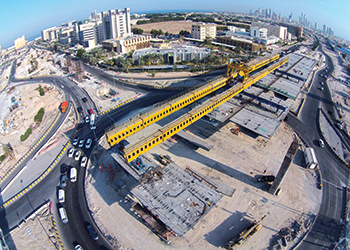Totally Transformed
01 December 2015
One of the world’s largest elevated road projects is currently under way in Kuwait under which simple three-lane roads are being transformed into a grand highway at a cost of close to $900 million.
The Jahra Road Development, one of Kuwait’s key infrastructure projects, has seen tremendous progress with two key flyovers opened in January and another flyover – the largest – slated for opening in the beginning of next year.
In its original state Jahra Road has been one of the core transport routes running through the heart of Kuwait, and was witnessing exceedingly busy traffic lines with consistently rising numbers of users. The Ministry of Public Works (MPW) has undertaken strategic plans to improve motorways and transport infrastructure in Kuwait, and the Jahra Road Development Project is one key project which will transform the simple three-lane roads into a grand unified highway, with six lanes in each direction, creating a two-level motorway that separates local service traffic below from through traffic above.
The project has been divided into five phases:
• Phase One: Jahra Roundabout (Sheraton Roundabout) to Airport Road.
• Phase Two: United Nations Roundabout to Hospital Road (Al-Sabah Medical District).
• Phase Three: Hospital Road to Al-Ghazali Road.
• Phase Four: Al-Ghazali Road to the Airport Road.
• Phase Five: Al-Ghazali intersection, linking with the Jamal Abdul Nasser Road project.
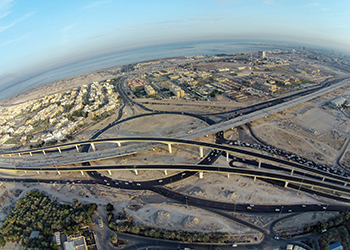 |
|
Aerial-view-of-the-UN-rou2 |
The mega project valued at KD264.76 million ($875.819 million), is one of the largest elevated road projects in the world and involves the construction of 17.7 km of segmental viaducts (7.3 km of the mainline Jahra Road, 2.4 km of link roads and 8 km of flyovers and ramps), 0.62 km of depressed road, a roundabout supported by two bridges and 10 pedestrian bridges. The at-grade road works include 2.6 km of mainline Jahra Road, 1 km of link roads and 15.1 km of service roads.
It is being developed by The Arab Contractors Osman Ahmed Osman and Company in partnership with Kuwait Arab Contractor. The consultants is a joint venture between Louis Berger Group and Pan Arab Consulting Engineers (Pace).
Work commenced on the project in September 2010 and is expected to be complete in August 2016 (excluding the Al-Ghazali interchange, which will begin the same month).
Speaking to Gulf Construction, Yaser Budustour, project engineer at MPW, says: “Jahra Road Development Project is one of Kuwait’s key infrastructure projects designed to ease the congestion issues faced in the country. The project has seen tremendous progress and this January saw the opening of two key flyovers. The ramps connect the Fourth Ring Road to Jahra Road and vice-versa, while bypassing the United Nations roundabout which has helped to greatly reduce the traffic previously experienced in that area.
“Towards the end of the year or beginning of next year, we will be opening more ramps and a significantly large portion of the mainline. One of the major milestones we are looking forward to will be in the beginning of 2016, and this will be the opening of one of the largest flyovers on the project (1.1 km long), connecting the Jahra mainline to the hospital bridge.”
The project aims to transform the existing roads into expressways that include 80-120 kmph multi-levelled highways designed to international standards, plus upgrading the existing service roads to provide additional traffic lanes with enhanced utilities.
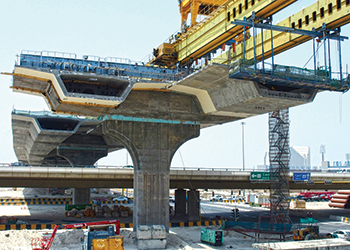 |
|
Al Jahra Road ... the construction method used for the elevated structures is precast, post-tensioned segmental bridge. |
Its objectives include addressing the growing traffic problem in the country, separating the through and local traffic, improving traffic safety, reducing traffic congestion in key areas, and improving the level of service for road users by increasing the total lanes to three dual-carriageway (total six on viaduct) and three for service (at-grade level) in each direction.
Ahmad Al Hassan, assistant undersecretary for Road Engineering Affairs at the MPW, says: “At the Ministry of Public Works, we are continuously studying the traffic situation and developing strategies to improve the roads, ease the traffic and ultimately allow for easier movement and reduced driving time. Jahra Road Development Project is one of our main projects, and one of our many on-going strategic road projects set to open within the next few years.”
The project is essentially a viaduct project. It has two interchanges with two levels – over the United Nations roundabout and Jahra Road with Airport Road – and two interchanges with three levels – the interchange of Jahra Road and Al-Ghazali, and Jahra Road with Hospital Road.
It also involves major utility works, including 3.5 km of storm water box culverts, 33 km of water lines relocation, 8 km of sanitary sewer relocation, 51 km of electric cables relocation, and 12 km of communication ducts.
According to latest updates, 82 per cent of the project (including material) has been completed. This, however, doesn’t include Al-Ghazali interchange, which has its own schedule in place. Other statistics include pile completion standing at 90 per cent, pile capping at 84 per cent, piers (84 per cent), pier heads (85 per cent), diaphragm (83 per cent), segment fabrication (90 per cent) and segment erection (76 per cent).
In project milestones, two ramps were opened in January 2015, which connect the Fourth Ring Road to Jahra Road and vice-versa, while bypassing the United Nations roundabout. By the year-end, there will be another milestone, with the opening of a portion of the mainline (4 km) and two ramps allowing for on and off access of the opened mainline. Similarly, in the beginning of 2016, the largest flyover, at the top of the three-level interchange, will be opened which will connect the Jahra mainline to the hospital bridge.
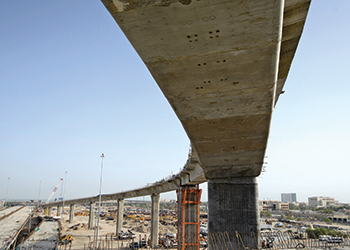 |
|
Mega project ... involves the construction of 17.7 km of segmental viaducts. |
The remaining works include construction of the trough, Jahra-Airport Road interchange, Jahra-Al-Ghazali interchange, and the main bridge between Al-Ghazali and Airport Road.
The humungous project will have approximately 4,579 piles, 499 piers, 255 diaphragms, 8,400 segments and 20 abutment piers. There is an average of 3,608 people working on the project.
On the landscaping part, there will be 1,311 palm trees planted and 10,547 other trees, 38,679 m run of hedges, 200,735 sq m of ground cover, 177,532 sq m of lawn and 10,300 sq m of rock garden. Additionally, 283 palms trees will be removed, relocated and replanted.
The project will also see asphalting of 8,940 sq m of walking track (2 m wide), 2,793 sq m of cobblestone paving, installation of 63 benches, 51 water coolers, 97 trash receptacles and 36 bus shelters.
The construction method used for the elevated structures is precast, post-tensioned segmental bridge. These segments have been manufactured in a precast yard constructed specifically for the project. Located in the Doha area in Kuwait, the precast yard covers a total surface of 150,000 sq m. The facility accommodates large-scale precasting techniques and equipment such as different type of moulds, gantry cranes, steel factory, storage area, batching plant, curing chambers and offices dedicated to the production of precast segments.
“Employing this system of precast segments has helped enhance the speed of production and has ensured better quality,” says the project’s resident engineer.
He explains the precast segmental balanced cantilever method of bridge construction involves a symmetrical erection of segments around a supporting pier.
“Bridge segments are lifted into position; their match-cast faces are aligned and coated with epoxy before bonding the segments together. Temporary post-tensioning is applied on each segment until its balancing segment is installed. Finally, cantilever tendons are installed and stressed from one segment to its counter-part on the other side of the pier.
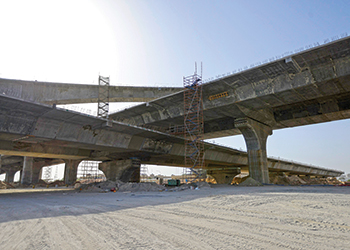 |
|
Al Jahra Road has two interchanges with two levels and two interchanges with three levels. |
“When all segments of a new cantilever have been erected and tendons stressed, a closure joint is made at mid-span called a stitch. Afterwards, continuity post-tensioning tendons are installed and stressed in-between the piers for span continuity.”
The erection process of bridge segments involves using launching gantries. These launching gantries were designed specifically for the project and weigh 500 tonnes each, and are 140 m long. The launching gantry is capable of lifting bridge segments weighing up to 120 tonnes. Currently, three launching gantries are functional on the project.
All stages of construction are in compliance with international standards, and are closely monitored by the project’s consultants: a joint venture relationship between Louis Berger Group and Pace. The rigorous monitoring and compliance policies in place are in adherence with QA/QC (quality assurance/quality control) measures.
For the superstructure, the casting of the segments started in the summer of 2012 and the segment erection in 2013. The deck is reinforced concrete box girder, which is erected using the balanced cantilever method, with pre-fabricated segments that are erected using an overhead launching gantry. Each segment is cast using the short-line method. The deck is pre-stressed by internal tendons and also external post-tensioning.
Like all major projects, the Jahra Road has its fair share of challenges as well, says the spokesman. These include dealing with existing traffic during construction, harsh weather conditions, utilities relocation, co-ordination for detours, co-ordination with the different stakeholders and the project location.
Commenting on the location, the spokesman says: “We are located in the heart of Kuwait’s industrial, residential, commercial, health and educational district. The Al-Ghazali Bridge is the only access to Shuwaikh port. Due to the heavy congestion in this road, it requires co-ordination with the other two projects that connect with it (Jamal Nasser Road and Jaber Causeway).”
The Ministry of Public Works in Kuwait is heavily investing in the execution of a number of different road projects, with the total projects value reaching approximately KD1.5 billion ($5 billion).


